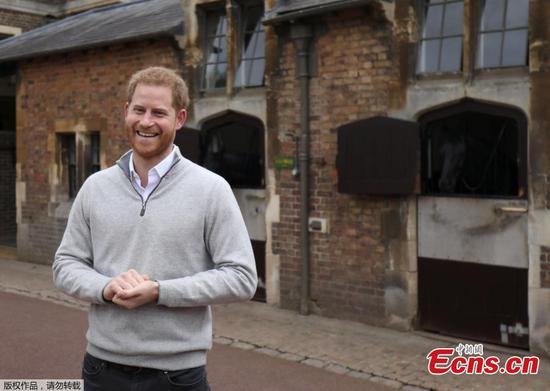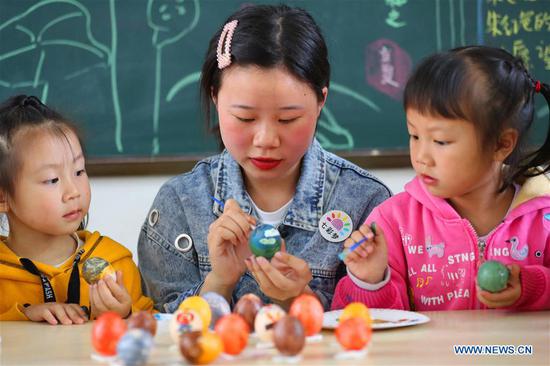
Visitors examine flowers at a national-level agricultural exhibition hall in Daicun village in Lanling, Shandong province. (Photo/China Daily)
18-35 demographic offers huge market potential
Since childhood, Dong Yichao dreamed of learning to fly and getting a private pilot's license, and he has gone to great lengths to realize his ambition.
Dong, 31, a civil servant in Huaiyu, a village in Yushan county, Jiangxi province, has spent nearly all his savings of 250,000 yuan ($37,212) on flying lessons and training.
In addition, every Friday evening, he made the 10-hour journey by train, bus and car for flying lessons at Zhoushan Mount Putuo Airport in Zhejiang province
He did this for a year before being granted a private pilot's license by the Civil Aviation Administration of China in 2017.
"This hobby has brought me so much pleasure, and when I flew a plane on my own for the first time, taking my wife and daughter to appreciate the beautiful scenery of the islands in Zhoushan from the air, all of my efforts seemed worthwhile," he said.
Dong is a so-called small-town youth, defined by the Central Committee of the Communist Youth League of China in a recent report as people from 18 to 35 years old who live in prefecture-level cities, counties and towns.
Although they come from lower-tier centers of population, in recent years small-town youths have been widely considered to be a main driver of the nation's consumption upgrade. Many analysts believe that winning them over means winning the market.
Xing Ziqiang, chief economist with investment bank Morgan Stanley China, said this age group will be a main driver of the consumption upgrade in the next decade, with consumption in third- and fourth-tier cities expected to reach 45 trillion yuan in 2030, compared with 15 trillion yuan in 2017.
There were estimated to be about 112 million small-town youths in China last year, according to mobile internet industry consultancy iiMedia Research.
Chen Ke, a senior partner with global consultancy Roland Berger, said that with lower housing prices in third- and fourth-tier cities, small-town youths have sizable disposable income and are more willing to spend a larger proportion of their income on daily consumption, compared with people of the same ages living in bigger cities.
"They also have an increasing desire to live a better material and spiritual life, are becoming more interested in personal products and are more willing to spend on entertainment and hobbies, as they have more spare time than their peers in big cities," he said.
In recent years, sales in many sectors in lower-tier cities have grown more quickly than in big cities, including clothing, food, beverages and home appliances, Chen added.
During Spring Festival in February, small-town youths in third- and lower-tier cities outperformed their peers in bigger centers of population in consumption across major e-commerce platforms, including the number of orders placed and the range of products bought.
In third- and fourth-tier cities, total online spending during Spring Festival rose by 55 percent year-on-year, compared with 51 percent in first-tier metropolises. Spending by small-town youths on beauty products rose by 7.8 percent year-on-year, compared with a 5.4 percent increase among their peers in larger cities, according to a report released by Tmall-Alibaba's e-commerce platform-and market research company Kantar Worldpanel.
Small-town youths have also boosted the movie industry. For example, in the first quarter of this year, some 56 percent of the box office for The New King of Comedy came from lower-tier cities, as did 46 percent for Crazy Alien.
During Spring Festival, the proportion of small-town youths who traveled rose by 101 percent year-on-year, compared with 50 percent among peers in bigger cities, according to major online travel agency Ctrip.
Ruan Tianying, deputy general manager of Western-style food chain Houcaller, said that with fastgrowing urbanization in China, lower-tier cities definitely offer great potential.
Houcaller, founded in Xiamen, Fujian province, in 1993, plans to operate about 400 stores in 100 Chinese cities, with more than two-thirds of them located in lower-tier centers by the end of this year.
Ruan said consumption per capita at Houcaller outlets is about 60 yuan, and about 80 percent of its more than 30 million customers a year are age 36 or younger.
"Opening a restaurant involves different factors, so we cannot reach lower-tier cities as quickly as fast-moving consumer goods do," he said, adding that in these cities, the market still needs to be educated about eating Western-style food, which involves a different dining etiquette from Chinese food.
"Usually, when we have become established in a second-tier city, we will expand to neighboring lower-tier cities. For example, we have developed very well in Xiamen (Fujian province), and based on this we will expand to smaller cities nearby," he said.
About 70 percent of small-town youths live from paycheck to paycheck, and most of their money goes on household items, luxuries, entertainment and travel, according to a report on this age group recently released by the Central Committee of the Communist Youth League of China.
"They also like quality products, good brands and are interested in being trendsetters," said Sun Hongyan, a researcher at the China Youth and Children Research Center.
Sun, the main author of the report, said 35.5 percent of small-town youths use mobile phones or electronic devices that feature the latest designs from well-known brands.
Huang Jing, 25, from Jiangyin, Jiangsu province, said she buys cosmetics, handbags and clothing from top brands through cross-border e-commerce platforms every month. Sometimes, she drives for one to two hours to neighboring bigger cities, such as Wuxi in Jiangsu, and Shanghai for shopping. She also plans two or three overseas trips every year.
"I don't have any housing or car loans, and don't have to worry about daily costs, as I live with my parents. I usually spend all my salary on daily consumption and entertainment, which is quite common for people such as myself," she said.
Jason Yu, managing director of Kantar Worldpanel, said small-town youths look to the internet for the latest information, products and lifestyles. The gap between young people in lower-tier cities and those in metropolises has narrowed greatly.
"Small-town youths now have broader horizons, are well informed, and some have even started to lead 'avant-garde' lifestyles," he said.
Short-video apps such as Douyin and Kuaishou offer major platforms for them to learn about the outside world. They also like to use social networking platforms such as Pinduoduo and WeChat, on which they can buy products, socialize with friends, learn about the latest fashion trends and make purchases, Yu said.
"For example, Pinduoduo asks consumers to invite friends to join the platform, to help reduce prices, which can be a good way of obtaining new customers and retaining them," he said. "Consumers also like purchasing activities that can strengthen connections with friends."
Sun said that because they face less work pressure and shorter commuting time, small-town youths have more free time compared with their peers in big cities. They mainly spend this time online or getting together with friends.
Some 88.7 percent of small-town youths surf the internet, 80.6 percent hang out with friends, and 60 percent watch movies, according to Sun's report.
Lan Fei, marketing center director for Guangzhou Weimeizi Industrial Co in Guangdong province, said people in lower-tier cities have huge consumption power.
In 2016, the company's oral care brand Saky reached customers in lower-tier cities for the first time. Moreover, the quality of oral care products in this market varies, so there is huge potential.
In addition to traditional sales channels such as supermarkets and stores, Saky was introduced to consumers in lower-tier cities by livestreaming hosts on social media platforms. The hosts used entertaining methods to introduce oral care products and educate consumers about the correct way to use them.
"On Kuaishou, the host placed some sesame powder on a piece of corn, showing that Saky's electric toothbrush could easily wash it away," he said. "The host also held a Saky electric toothbrush against a balloon (which did not burst) to demonstrate that its power could not damage teeth."
Sales of Saky products in the lower-tier market only account for about 20 percent of the total, but they have quadrupled in the past two years.
"If you can prove to small-town youths that the products are useful, they are willing to pay," Lan said. "Some innovative Saky products have also seen rapid growth in lower-tier markets, including one that removes stains from teeth."
Chen, from Roland Berger, said that while small-town youths are narrowing the gap with their counterparts in bigger cities in many ways, they still have many distinct demands. If companies want to win them over, it is important for them to have a deep understanding of lower-tier markets and to draw up strategies accordingly, whether in building brand awareness, or providing specialized products and distribution channels.
For example, while helping a jewelry company to access lower-tier markets, he found that jade inlaid with gold is very popular, although it is considered unfashionable by consumers in large cities.


















































